
[ad_1]
It had taken Dr Saabiha Sadiq two decades to set up three optometry practices in the KwaZulu-Natal province in South Africa. This past summer, when the country witnessed its worst civil unrest since the end of apartheid in the 1990s, Sadiq saw all three ransacked within just 15 hours.
The arrest of former president Jacob Zuma for failing to appear at a corruption inquiry triggered violent protests by his supporters and was followed by days of riots, destruction of public and private property and looting in many parts of the country. The South African government said 337 people had lost their lives in the violence. The president’s office had issued a statement saying the highest number of deaths were recorded in KwaZulu-Natal where 258 had been killed. The severity of the violence led President Cyril Ramaphosa to label it an attempted “insurrection”.
 he South African government said 337 people had lost their lives in the violence. (Reuters Photo)
he South African government said 337 people had lost their lives in the violence. (Reuters Photo)
In the KwaZulu-Natal province, two of Sadiq’s practices as well as her husband’s, are located in Kwamashu, a township some 12 km north of Durban. In South Africa, ‘township’ is a term commonly used to refer to “underdeveloped, urban, residential areas that during apartheid were reserved for non-whites (Africans, Coloureds and Indians) who lived near or worked in areas that were designated ‘white only’,” according to a research paper by South Africa’s Department of Provincial and Local Government.
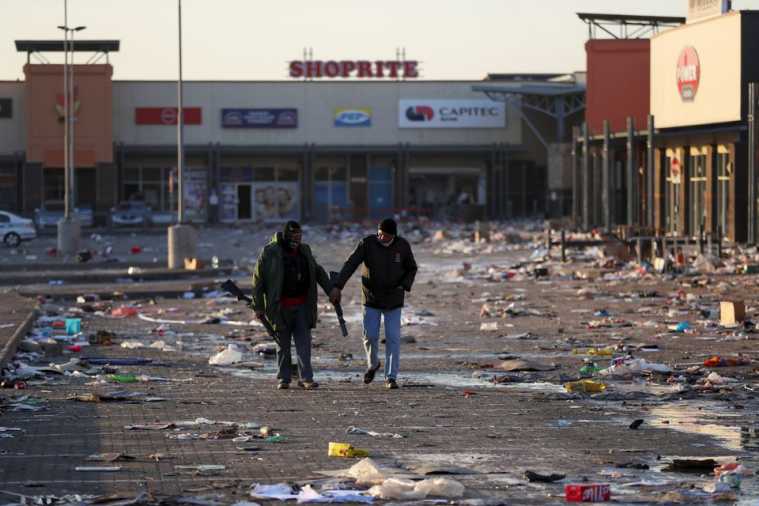 The president’s office had issued a statement saying the highest number of deaths were recorded in KwaZulu-Natal where 258 had been killed. (Reuters Photo)
The president’s office had issued a statement saying the highest number of deaths were recorded in KwaZulu-Natal where 258 had been killed. (Reuters Photo)
Soon after the unrest started on July 10, word spread across social media platforms. The next day, residents across KwaZulu-Natal started seeing looting and ransacking. “That was just the beginning. Things began intensifying and roads into these townships were closed. By evening, everything was out of control,” Sadiq said.
At midnight on July 11, Sadiq and her family, who belong to the Indian South African community, started getting alerts from their security company that the alarms had triggered off at their practices one after another. “There was no army, no police and so the looters were left to do whatever they wanted to do.”
 One of Sadiq’s practices that were destroyed during the unrest in July in the KwaZulu-Natal province. (Photo: Marvin Govender)
One of Sadiq’s practices that were destroyed during the unrest in July in the KwaZulu-Natal province. (Photo: Marvin Govender)
Reuters reported crowds clashing with police and ransacking across South Africa, resulting in deaths. Despite the presence of the country’s soldiers on the streets attempting to curb the unrest, violence persisted and spilled outside the KwaZulu-Natal province to Johannesburg, and the surrounding Gauteng province.
Researchers told indianexpress.com that the riots were fueled by factors like poverty, inequality, growing joblessness, disappointment with the government and anger at the difficulties that ordinary people have been facing, three decades since the end of white minority rule and the election of Nelson Mandela in South Africa’s first free and democratic vote in 1994.
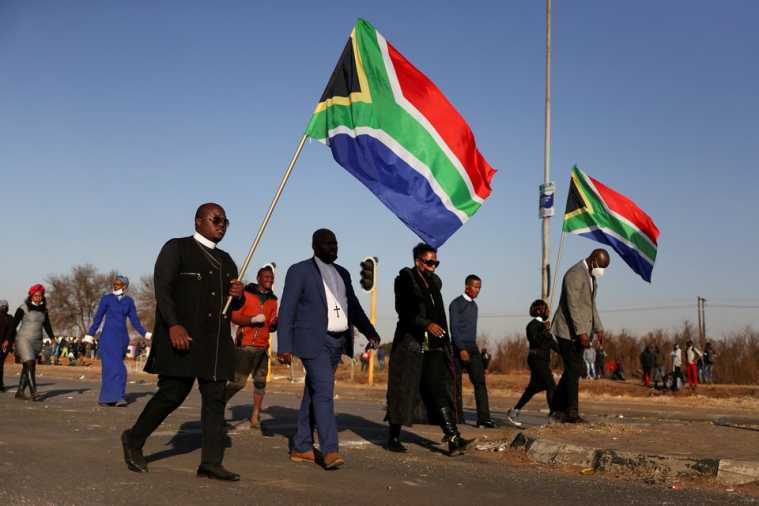 Religious leaders carrying South African flags walk near a looted shopping mall as the country deploys army to quell unrest linked to the jailing of former South African President Jacob Zuma, in Vosloorus, South Africa, July 14, 2021. (Reuters Photo)
Religious leaders carrying South African flags walk near a looted shopping mall as the country deploys army to quell unrest linked to the jailing of former South African President Jacob Zuma, in Vosloorus, South Africa, July 14, 2021. (Reuters Photo)
Town with Indian majority ‘unfairly’ singled out
The July unrest had one distinctive feature: vigilante killings. While the violence had swept across the country, it was most severe in Phoenix where 36 people were killed as a result of vigilantism. In August, Police Minister Bheki Cele said 33 of those killed were Africans and arrested 22 suspects, 18 of them Indians, who later appeared in court on charges of murder and 52 counts of attempted murder.
“There were similar attacks in other towns, but the number of people killed may not have been as high as that in Phoenix,” a resident said, requesting anonymity. She said “her town had been unfairly singled out as a hotbed of racial violence by groups with vested interests, because of the ethnicities of the accused and the victims”.
According to the 2011 census by the South African government, 85% of Phoenix’s population are of Indian or Asian descent. The province of KwaZulu-Natal that was created in 1994 by joining the provinces of Natal and KwaZulu bantustan, was one of the first places where Indians were settled by British colonists after they were transported as indentured labourers from the Indian subcontinent post 1860. In South Africa today, Indians form about 2.5% of the population according to the government’s census records.
“The Indian community stood their ground, having been victims before of similar violence in 1949 and 1985. Indians are generally considered soft targets,” said the Phoenix resident. In January 1949, Indians living in Durban and nearby areas were targeted by black South Africans instigated by political leaders, who engaged in rioting, violence, looting, rape and killing. The aftermath of the Durban riots saw the destruction of public and private property, people injured and the deaths of close to 150 people.
 A view of Inanda township in South Africa that skirts Phoenix. (Photo: OSINT)
A view of Inanda township in South Africa that skirts Phoenix. (Photo: OSINT)
Legacy of apartheid
In 1985, in Inanda, a settlement founded by Mahatma Gandhi that borders Phoenix, Indian South Africans were again subjected to racial violence. A Los Angeles Times report from 1985 on the incident says: “Some accounts said the racial violence was prompted by the refusal of Asian traders to close shops and businesses in response to a black-organised boycott. Reporters said blacks’ anger was probably directed at Asians also because of their participation in a year-old tri-racial Parliament that excludes the nation’s 22 million blacks, who make up 70% of the population.”
Phoenix is a suburban town where a majority of the residents are middle class, educated and employed. On the other side of the M25 highway is Inanda township, where residents predominantly live on social grants and in low cost housing provided by the government.
Inanda has high unemployment and many black South Africans commute to Phoenix for jobs and access to healthcare facilities. “There is high inequality between someone living in Inanda township compared to Phoenix. Inanda is a very big township, so you will find a mix of educated and uneducated people. No Indians live there,” said Siboniso Mngadi, a Durban-based journalist who has been covering the unrest.
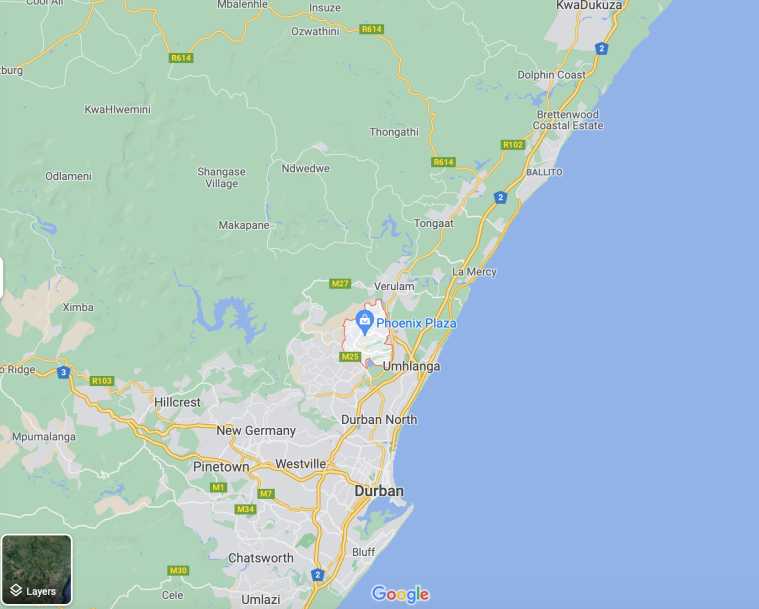 A Google map showing Phoenix.
A Google map showing Phoenix.
Marvin Govender, a representative of the local residents’ association in Phoenix, believes that the recent unrest is rooted in apartheid spatial planning and urban residential segregation that has remained in the country. “Indians have good jobs in the government and the private sector because that is our ethos. I think we are being blamed for being progressive in this country which is unfair,” Govender said.
He believes that the violence was a result of a combination of simmering resentment and envy towards the Indian South African community. “We came as slaves with nothing on our backs and we’ve built everything from scratch. They have a Facebook page called ‘Zulu Nationals’ where politicians are also fanning the flames. We’ve worked hard to build our lives and now they want us to go back to India.”
Ineffective governance blamed
In Phoenix, the Indian South African community said politicians had intentionally provoked racial tensions by using inflammatory rhetoric and that security forces had failed to protect ordinary people.
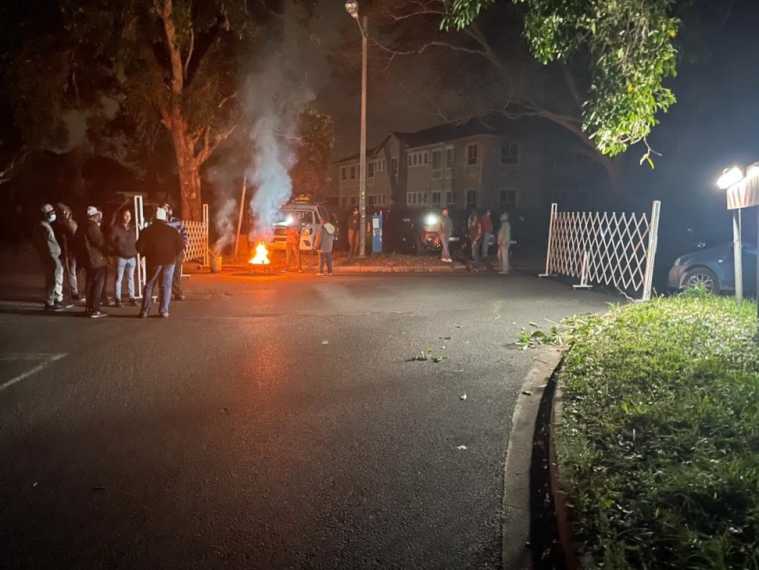 Indians in South Africa formed groups to barricade access to communities and patrol neighbourhoods at night during the unrest. (Photo: Marvin Govender)
Indians in South Africa formed groups to barricade access to communities and patrol neighbourhoods at night during the unrest. (Photo: Marvin Govender)
“People automatically shifted to military mode to defend their families and community. We didn’t go into the black community, the black community came into ours. Yes, there were vigilantes, but you will get that in any community. When the police decide to hide away and don’t come through, when the army doesn’t come through, what then?” Govender said.
The Indian South African community forums began forming groups to physically stand guard outside homes and businesses. “They weren’t sleeping; they were safeguarding their property because there was nobody to protect them. These people who are suspects for having killed people say they were protecting their people and their houses and in that process, they killed people,” said Mngadi.
But not all black South Africans who were killed were involved in the violence and looting, the victims’ families testified during the investigation. Some had just happened to have the misfortune of getting caught by these vigilante groups.
“There is one victim named Ntuthuko, who was shot in the head and had a bullet stuck in his jaw. He told me that he was just driving by when they fired at him. Fortunately he survived,” said Mngadi. In another case, a Phoenix resident was driving alone when a group of men stopped her. “When they saw that she wasn’t Indian, they asked her to get out of the car. Then they took away her phone and burned her car. But it is not like all people who were killed were trying to rob and loot.” This incident was corroborated by South Africa’s Minister of Police Bheki Cele during a press briefing.
 The Indian community began receiving screenshots of WhatsApp messages and social media posts where threats were made urging the use of heavy firearms against Indians in South Africa, that residents say further inflamed tensions. (Photo: Marvin Govender)
The Indian community began receiving screenshots of WhatsApp messages and social media posts where threats were made urging the use of heavy firearms against Indians in South Africa, that residents say further inflamed tensions. (Photo: Marvin Govender)
South Africa’s illegal gun problem
Approximately a month ago, Cele announced that the agency had seized more than 150 firearms for ballistic testing from private security companies that were being investigated for their alleged role in the killing of people in Phoenix during the unrest. “There are seven of them being investigated, and three were leading the charge. The three companies are Reaction Unit, VIP security and others,” local news reports quoted Cele saying.
Reaction Unit’s head Prem Balram did not respond to indianexpress.com’s multiple requests for comment, but during the initial stages of the investigation, he had told local press that he “welcomed” the investigation because “they had no part in any of the violence during the unrest.”
South Africa has one of the world’s largest private security industries according to government data. For most of his life, 51-year-old Vegan Paul has lived in Phoenix and is familiar with the business of private security in the country because of his social circle. “Each house in South Africa is affiliated with a security company because the South African Police Service (SAPS) is very ineffective. These private companies have taken over the jobs and the responsibility of the police. It is an ineffective government that has forced the burgeoning of these companies. Despite their presence, there are high levels of crime here,” he said.
South Africa has relatively strict legislation regulating the possession of firearms, implemented by the Firearms Control Act of 2004, that replaced a 1968 law that had permitted relatively widespread access to licensed firearms. Despite that, research by Guy Lamb, lecturer at Stellenbosch University, published in 2018 showed that the majority of illegal guns in circulation in South Africa had been originally licensed to civilians and private security companies that eventually found their way to criminals, through loss and theft.
The widespread circulation of illegal firearms and high crime rates in the country, combined with the historical experiences of the Indian South African community, have forced many to turn to these private companies, members of the community told indianexpress.com. “Reports of private citizens (in the Indian community) being armed are an exaggeration. I was out at the forefront defending my community. We had to do this. We were confronted with people who were ready to commit arson etc.,” said Paul.
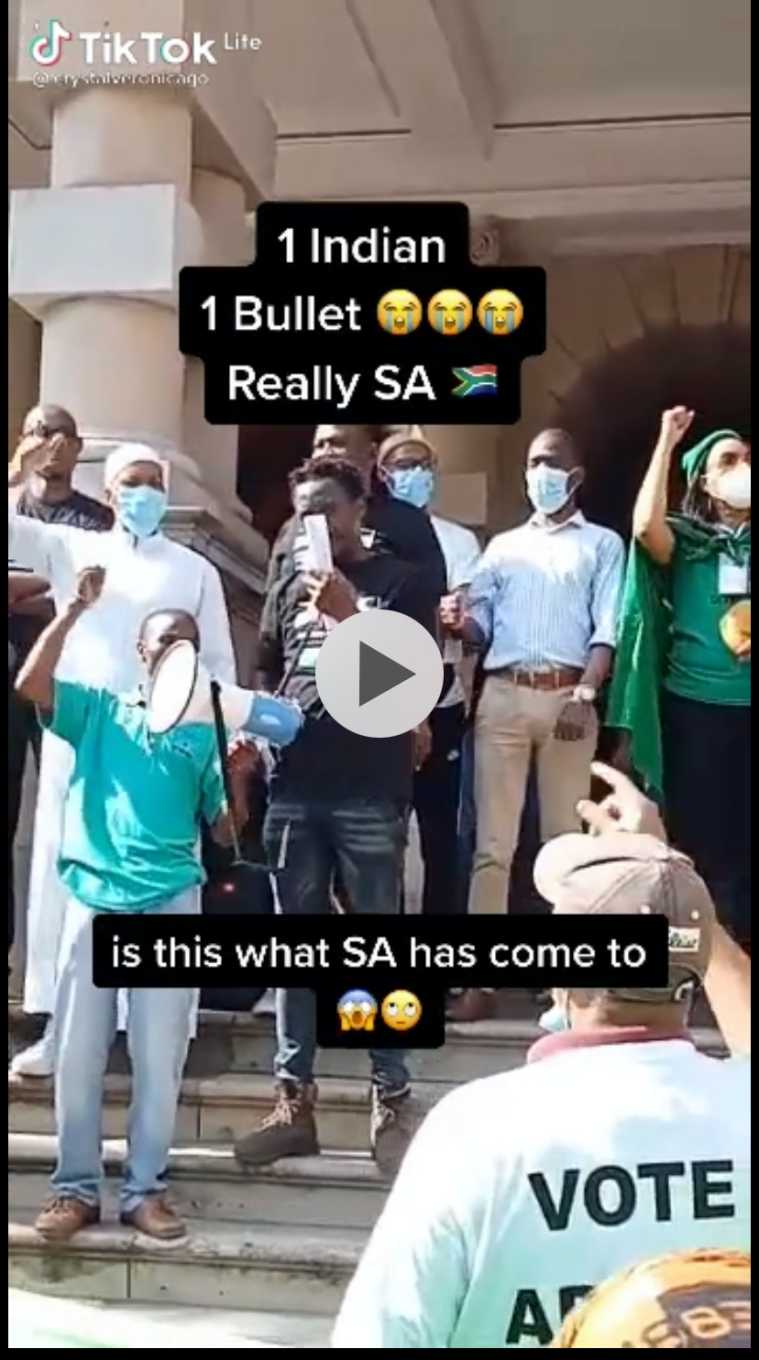 A TikTok video circulated during the unrest that showed black South Africans using loudspeakers. The video caption reads: “1 Indian; 1 Bullet, Really SA…is this what SA has come to”. (Photo: Screenshot/Marvin Govender)
A TikTok video circulated during the unrest that showed black South Africans using loudspeakers. The video caption reads: “1 Indian; 1 Bullet, Really SA…is this what SA has come to”. (Photo: Screenshot/Marvin Govender)
He points to social media posts and unverified WhatsApp messages that instilled fear among members of the Indian community that began circulating after Zuma’s arrest. Among the posts reviewed by indianexpress.com, there was a TikTok video where black South Africans can be seen using loudspeakers. The screenshot caption reads: “1 Indian; 1 Bullet, Really SA…is this what SA has come to”.
It was these videos that prompted 42-year-old Ubaidulla Abdul Aziz to “defend” his community in Phoenix. Aziz said he would sleep with his shoes on during the week of the violence in case he needed to run out to help. “They were coming with weapons and threatening us. We used to light bonfires and sit outside all night. We were living in fear. We were not going to sit back and allow them to attack us”.
The rhetoric by Zuma’s children and political supporters only made matters worse. 37-year-old Duduzane Zuma published a YouTube video urging looters to “steal responsibly” and had claimed that South Africa was “one massacre away”. Just days before the unrest started, Zuma wrote on Twitter: “Let everything burn. #FreeJacobZuma”.
Let everything burn. #FreeJacobZuma
— Duduzane Zuma (@Duduzane__Zuma) July 9, 2021
“After looting, the black South Africans had to pass through Phoenix and that was when the problem started,” said Ntomboxolo Noxy, who has been living in the town for close to two decades. The looters, she said, were most likely on their way back to Kwamashu and other townships, using the only route available.
Noxy said she knew some of the black South Africans who were killed in the violence.
In November this year, South Africa will hold municipal elections and the ruling African National Congress (ANC) that was responsible for South Africa’s freedom from apartheid, is in dire straits. The party has found it difficult to distance itself from Zuma’s corruption and legal challenges, and is tackling diminishing support, political in-fighting and financial difficulties. The impact of Covid-19 on ordinary South Africans has further dented the support for the ANC.
“We are in an election year and this is politics at its best,” the Phoenix resident said, adding she strongly believed that the unrest was deliberately instigated in the run-up to the elections. “Race is a sensitive issue and political parties use that as a trump card to gain votes.”
After police began arresting members of the Indian community for incidents linked to July’s unrest, Paul set up the Phoenix Justice Project to call for the release of those incarcerated and offer assistance to their family members.
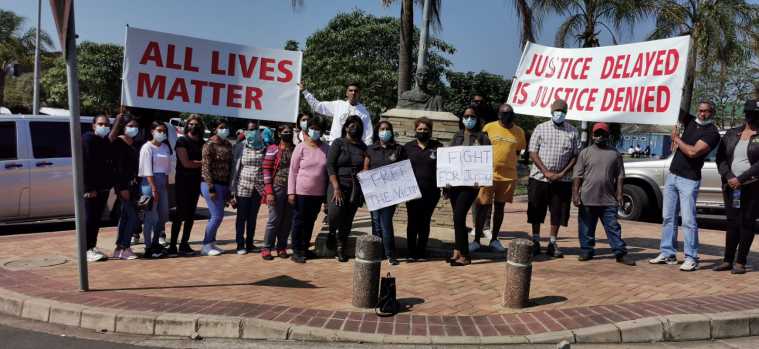 Vegan Paul and families of arrested Indian community members protest outside the Verulam Magistrate’s Court. (Photo: Vegan Paul)
Vegan Paul and families of arrested Indian community members protest outside the Verulam Magistrate’s Court. (Photo: Vegan Paul)
For the past two weeks, he has been protesting with families of those arrested outside the Verulam Magistrate’s Court. Paul said the justice system had been unfair to Indians arrested following the unrest. “It is evident that there is a set of rules for the ANC government and a different set of rules for the Indians and the other races.”
The Director of Public Prosecutions of the KwaZulu-Natal Division at the National Prosecuting Authority of South Africa (NPA), Adv. Elaine Zungu told indianexpress.com, “Please note that as the NPA, our work is based on evidence. We receive case dockets and we must make a decision on whether a case must be enrolled in court or not, based on the evidence. All these decisions are made objectively. We have no further comment on the matter.”
“Many South African Indians don’t treat black South Africans with respect. Even (in professional workspaces) in Durban, there are many Indians who don’t treat blacks with respect. But in my case, I have fought and retained my dignity in Phoenix, but not all black South Africans have strength and courage to fight for themselves,” said Noxy.
Nearly two months on, Phoenix is trying to come to terms with what happened. “We are trying to solve this problem as (community) leaders in Phoenix. There is more that needs to be done to bring these communities together,” Noxy said.
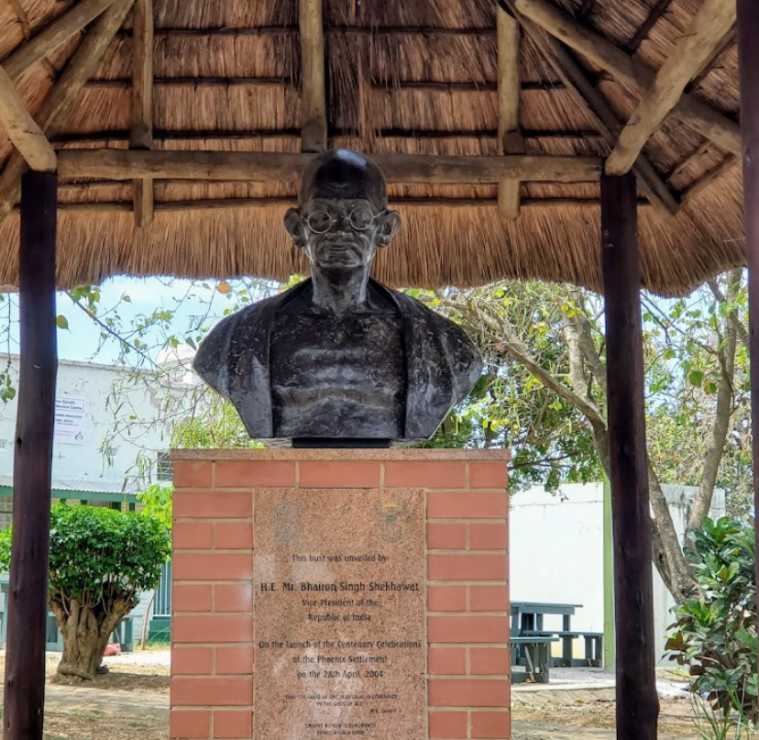 A bust of Mahatma Gandhi inside the complex of the Phoenix Settlement in Inanda. (Photo: OSINT)
A bust of Mahatma Gandhi inside the complex of the Phoenix Settlement in Inanda. (Photo: OSINT)
A 15-minute drive from the heart of the town that witnessed such severe violence weeks ago, is the complex of the Phoenix Settlement in Inanda, established by Mahatma Gandhi in 1904. But the most well-known Indian inhabitant of the Phoenix metropolitan area holds little value or sentiment for many of the town’s Indian South African residents today. “If we had subscribed to his policies (of non-violence), we would have been dead,” said Govinder.
[ad_2]
Source link